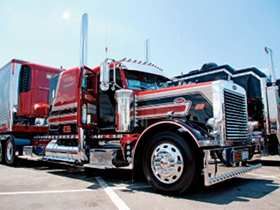Review Questions - Click On The Picture To Begin...

- 25 feet
- 50 feet
- 75 feet
- 100 feet
Quote From The CDL Manual:
The person watching a placarded vehicle must:
- Be in the vehicle awake, not in the sleeper berth, or within 100 feet of the vehicle and have it within clear view,
- Be aware of the hazards of the materials being transported,
- Know what to do in emergencies, and
- Be able to move the vehicle if needed.
- 10 feet
- 20 feet
- 5 feet
- 15 feet
Quote From The CDL Manual:
Never park with Division 1.1, 1.2 or 1.3 (Class A or B) explosives within 5 feet of the traveled part of the road. Except for short periods of time needed for vehicle operation necessities (e.g. fueling), do not park within 300 feet of:
- a bridge, tunnel or building
- a place where people gather
- an open fire.
- Drivers are responsible for preparing their own route plan
- Receivers prepare the route plan in advance and give the driver a copy
- Shippers prepare the route plan in advance and give the driver a copy
- Carriers prepare the route plan in advance and give the driver a copy
Quote From The CDL Manual:
If transporting Division 1.1, 1.2 or 1.3 (Class A or Class B) explosives, you must have a written route plan and follow that plan. Carriers prepare the route plan in advance and give the driver a copy. You may plan the route yourself if you pick up the explosives at a location other than your employer's terminal. Write out the plan in advance. Keep a copy of it with you while transporting the explosives. Deliver shipments of explosives only to authorized persons or leave them in locked rooms designed for explosives storage.
- 200 feet
- 150 feet
- 300 feet
- 250 feet
Quote From The CDL Manual:
Never park with Division 1.1, 1.2 or 1.3 (Class A or B) explosives within 5 feet of the traveled part of the road. Except for short periods of time needed for vehicle operation necessities (e.g. fueling), do not park within 300 feet of:
- a bridge, tunnel or building
- a place where people gather
- an open fire.
- 25 feet
- 200 feet
- 300 feet
- 100 feet
Quote From The CDL Manual:
You may park a placarded vehicle (not laden with explosives) within 5 feet of the traveled part of the road only if your work requires it. Do so only briefly. Someone must always watch the vehicle when parked on a public roadway or shoulder. Do not uncouple a trailer and leave it with hazardous material on a public street. Do not park within 300 feet of an open fire.
- Class 3 materials only
- Class 2 materials only
- Class 1 materials only
- Road flares should never be used around placarded HAZMAT trucks
Quote From The CDL Manual:
No Flares You may break down and have to use stopped vehicle signals. Use reflective triangles or red electric lights. Never use burning signals, such as flares or fuses, around:
- A tank used for Class 3 (flammable liquids) or Division 2.1 (flammable gas) whether loaded or empty.
- A vehicle loaded with Division 1.1, 1.2, or 1.3 (Class A or B) explosives.








 TT On Facebook
TT On Facebook